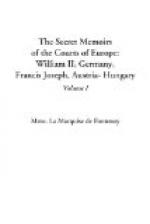Duke Ernest-Gunther was a suitor for the hand of quite a large number of princesses, and among those to whom he proposed were the daughters of the Prince of Wales and of the latter’s brother, the Duke of Coburg, his suit being rejected with touching unanimity in each instance, in consequence of his unenviable reputation. Yet strangely enough, as stated previously, he seems to have developed into an exemplary husband, although his marriage was contracted under circumstances which, verged on a tragedy; for his wife, a mere seventeen-year-old girl, just issuing from the school-room when he made an offer for her hand, was literally flung into his arms by both her parents, who were determined to separate from each other, and who had been informed by Emperor Francis-Joseph of Austria, and by King Leopold of Belgium, that no such step could be tolerated until after the marriage of little Princess “Dolly,” the only daughter of this ill-matched couple. The betrothal took place in due course at Vienna. But before the marriage could follow, the young girl’s mother, namely, Princess Louise of Coburg and of Belgium, deliberately eloped from the Austrian capital with her husband’s chamberlain, the Hungarian Count Keglewitch; and what was worse, took her daughter with her. The trio fled to Nice, where they were visited by King Leopold, who after endeavoring in vain to persuade the princess to return to her husband at Vienna, discarded her in hot anger, declaring that she was no longer his daughter!
The next act in the drama was a challenge issued by Prince Philip of Coburg against Count Keglewitch, who left Nice for the encounter: the duel was fought in the army riding-school at Vienna, the commander of the metropolitan garrison and the minister of war acting as seconds to Prince Philip, although duelling is strictly forbidden by law in Austria, as it is in Germany. Prince Philip received a painful wound in the hand, and the count forthwith left to rejoin the princess at Nice. The publicity given to




